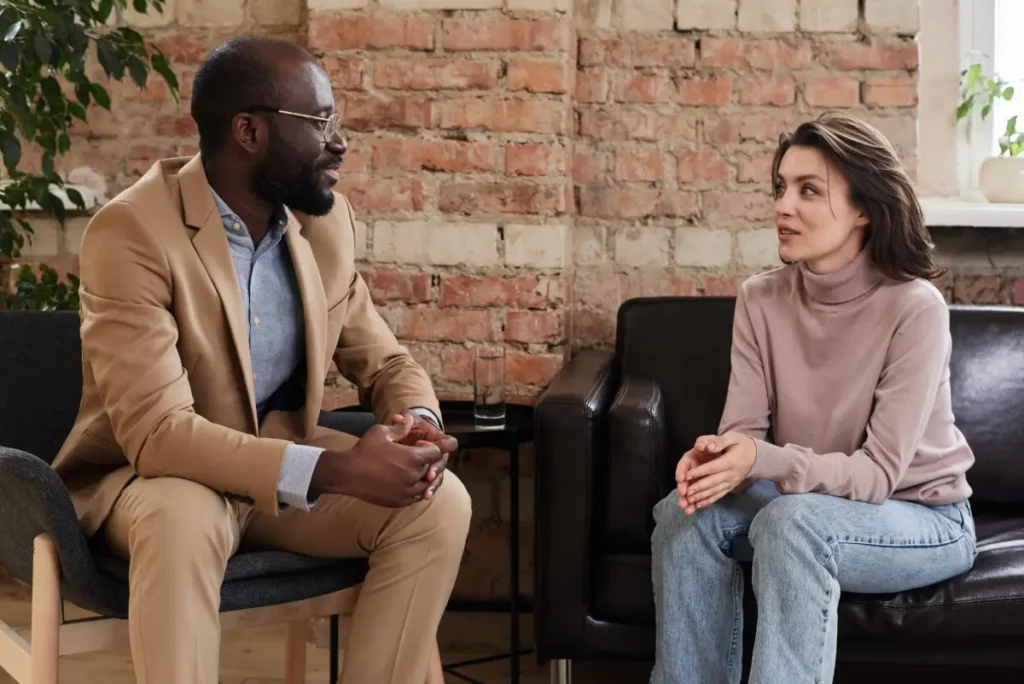Do you ever find yourself trapped in a maze of worry and unease when you’re in social situations? You’re not alone. Social anxiety, that familiar knot in your stomach and the racing heart when facing others, is more common than you might think. The good news? There’s a way out of that maze, and we’re here to guide you. In this blog, we’re delving deep into the world of social anxiety and unveiling a powerful solution (CBT) that can help you regain control and confidence in social settings.
Get ready to discover what CBT is all about, the strategies it employs, and why it’s so effective. We’ll share real practical tips, and expert insights that will equip you with the tools to step out of your comfort zone and embrace social situations with newfound confidence.
Contents
Understanding Social Anxiety and Its Impact
 Social anxiety is an intense and irrational fear of being examined very closely or judged by others. It’s a mental health condition that can have a profound impact on the lives of those who experience it. Imagine feeling an overwhelming sense of dread when you have to speak in public, meet new people, or even attend a social gathering. Social anxiety isn’t just about nervousness; it’s a persistent fear of negative judgment, embarrassment, or humiliation in social situations.
Social anxiety is an intense and irrational fear of being examined very closely or judged by others. It’s a mental health condition that can have a profound impact on the lives of those who experience it. Imagine feeling an overwhelming sense of dread when you have to speak in public, meet new people, or even attend a social gathering. Social anxiety isn’t just about nervousness; it’s a persistent fear of negative judgment, embarrassment, or humiliation in social situations.
The Impact of Social Anxiety:
The impact of social anxiety goes beyond momentary discomfort. It can affect various aspects of a person’s life:
- Isolation: Individuals with social anxiety may withdraw from social activities, leading to feelings of loneliness and isolation.
- Career and Education: It can hinder career progression, networking, and educational opportunities due to avoidance of social situations.
- Physical Symptoms: Social anxiety often brings physical symptoms like sweating, trembling, nausea, and a racing heart, which can be distressing.
- Mental Health: Left unaddressed, social anxiety can lead to other mental health issues like depression and low self-esteem.
However, the good news is that there is hope, and Cognitive-Behavioral Therapy (CBT) is a highly effective approach for tackling social anxiety. In the upcoming sections, we’ll explore CBT’s strategies in detail and how they can help you conquer social anxiety, step by step. Say goodbye to social anxiety, and embrace a life full of confidence and meaningful social interactions.
The Core Principles of CBT
 At its core, CBT operates on several fundamental principles. So, let’s explore these principles and how they can be applied to alleviate social anxiety:
At its core, CBT operates on several fundamental principles. So, let’s explore these principles and how they can be applied to alleviate social anxiety:
1. The Cognitive-Behavioral Connection
CBT recognizes the intricate relationship between our thoughts, our emotions, and our actions. In the context of social anxiety, this means that the way we think about social situations directly influences how we feel and how we behave.
2. Identifying Negative Thought Patterns
CBT begins by helping individuals identify negative and irrational thought patterns that contribute to social anxiety.
3. Challenging and Restructuring Thoughts
Once negative thought patterns are identified, CBT focuses on challenging and restructuring these thoughts. Individuals learn to question the accuracy of their beliefs and replace them with more rational and balanced thinking.
4. Emotional Regulation
CBT emphasizes the role of thoughts in influencing emotions. By changing the way we think about social situations, we can directly impact our emotional responses. This is a critical aspect of managing social anxiety.
5. Gradual Exposure
This step involves confronting fears in a systematic and controlled manner, challenging avoidance behaviors.
6. Developing Coping Strategies
CBT equips individuals with practical coping strategies to manage the physical and emotional symptoms of anxiety. These may include deep breathing, relaxation techniques, and mindfulness practices.
7. Homework Assignments
CBT often involves homework assignments that encourage individuals to apply what they’ve learned in therapy to real-life situations.
8. Self-Monitoring
Individuals are encouraged to self-monitor their thoughts and feelings during social interactions, gaining awareness of how thought patterns influence their anxiety levels.
9. Long-Term Skill-Building
CBT is not just about symptom reduction; it’s about building long-term skills to manage social anxiety and other challenges.
By applying these core principles of CBT, individuals with social anxiety can gradually transform their thinking patterns, emotional responses, and behaviors.
CBT Strategies for Social Anxiety

Cognitive-Behavioral Therapy (CBT) offers a comprehensive toolbox of techniques and strategies specifically tailored to address social anxiety. These strategies are designed to help individuals change their thought patterns, emotional responses, and behaviors, ultimately leading to reduced social anxiety. Let’s explore some of the key CBT techniques used to manage social anxiety:
Cognitive Restructuring
- Description: Cognitive restructuring involves identifying and challenging negative thought patterns associated with social anxiety. Individuals learn to replace these thoughts with more realistic and balanced beliefs.
- Application: When faced with a social situation, someone with social anxiety might replace a catastrophic thought like “Everyone will think I’m a failure” with a more rational belief like “It’s okay to make mistakes, and people are not judging me as harshly as I think.”
Exposure Therapy
- Description: Exposure therapy is a cornerstone of CBT for social anxiety. It involves gradual and controlled exposure to feared social situations, helping individuals confront their fears and reduce avoidance behaviors.
- Application: Someone with social anxiety might start by speaking to a trusted friend, then progressively work up to larger social gatherings, ultimately mastering public speaking or networking events.
Relaxation Techniques
- Description: Relaxation techniques, such as deep breathing, progressive muscle relaxation, and mindfulness, help individuals manage the physical symptoms of anxiety often associated with social situations.
- Application: Practicing deep breathing exercises before and during social events can help individuals stay calm and reduce the physical symptoms of anxiety.
Social Skills Training
- Description: Social skills training teaches individuals effective communication and interpersonal skills, boosting their confidence and reducing social anxiety.
- Application: Learning how to start and maintain conversations, active listening, and assertiveness can enhance social interactions and decrease anxiety.
Thought Records and Journals
- Description: Thought records and journals help individuals track and analyze their thoughts and emotional responses during social situations. This promotes self-awareness and the identification of unhelpful thought patterns.
- Application: By documenting their thoughts and feelings in social situations, individuals can identify recurring negative thought patterns and work on replacing them with healthier alternatives.
Role-Playing
- Description: Role-playing allows individuals to practice social interactions and challenging situations in a safe, supportive environment, typically with a therapist or a trusted friend.
- Application: Role-playing can help individuals build confidence in specific social scenarios, such as job interviews or social gatherings.
Cognitive Distancing
- Description: Cognitive distancing encourages individuals to step back and view social situations objectively, reducing the emotional intensity and self-criticism associated with social anxiety.
- Application: By distancing themselves from their anxious thoughts and viewing situations from an outsider’s perspective, individuals can gain a more balanced and realistic viewpoint.
Behavioral Experiments
- Description: Behavioral experiments involve testing the validity of negative beliefs in real-life situations, challenging the accuracy of one’s assumptions.
- Application: Someone with social anxiety may experiment by engaging in a social event with the hypothesis that their feared outcomes won’t materialize, providing evidence to refute their negative beliefs.
By combining cognitive restructuring, exposure therapy, relaxation techniques, and other strategies, individuals can gradually overcome social anxiety and regain control over their social lives.
Effectiveness of CBT for Social Anxiety
 Numerous studies have consistently demonstrated the effectiveness of Cognitive-Behavioral Therapy (CBT) in treating social anxiety. Research findings and statistics underscore the success of this therapeutic approach:
Numerous studies have consistently demonstrated the effectiveness of Cognitive-Behavioral Therapy (CBT) in treating social anxiety. Research findings and statistics underscore the success of this therapeutic approach:
- High Success Rates: CBT has shown impressive success rates in reducing the symptoms of social anxiety. Studies indicate that a significant proportion of individuals experience a noticeable improvement in their social anxiety symptoms after completing a course of CBT.
Benefits of CBT for Social Anxiety:
- Empowerment: CBT empowers individuals to take an active role in managing their social anxiety, giving them a sense of control and confidence.
- Practical Skills: CBT equips individuals with practical strategies for real-life situations, making it a highly applicable approach.
- Reduced Relapse Rates: CBT has lower relapse rates compared to medication-only treatments, indicating its effectiveness in maintaining long-term progress.
- Improved Quality of Life: Beyond symptom reduction, CBT enhances overall well-being by enabling individuals to engage in social activities, pursue career opportunities, and develop meaningful relationships.
- Individualized Approach: CBT is highly adaptable and tailored to the unique needs of each individual, ensuring a personalized and effective treatment plan.
The effectiveness of CBT in addressing social anxiety is not only backed by research but also celebrated by those who have experienced significant improvements in their social lives, ultimately enjoying the benefits of reduced anxiety and enhanced confidence.
How Many Sessions Are There in CBT for Social Anxiety?
 The number of sessions in Cognitive-Behavioral Therapy (CBT) for social anxiety can vary based on individual needs and circumstances. Generally, CBT for social anxiety may involve:
The number of sessions in Cognitive-Behavioral Therapy (CBT) for social anxiety can vary based on individual needs and circumstances. Generally, CBT for social anxiety may involve:
- Short-Term CBT: This typically comprises 12 to 16 sessions, designed for rapid symptom relief, focusing on key strategies to manage social anxiety effectively.
- Long-Term CBT: Extending to 20 sessions or more, long-term CBT allows for a more comprehensive exploration of underlying issues, continued skill-building, and addressing relapses.
The frequency of CBT sessions can be influenced by factors such as:
- Severity of social anxiety
- Consistency and commitment to attending and actively engaging in therapy sessions.
- Therapist Expertise
- Complexity
Ultimately, the number of CBT sessions is flexible and tailored to individual needs and progress, with the goal of equipping individuals with the skills to manage social anxiety effectively.
Self-Help CBT Techniques and Exercises
Initiating self-help Cognitive-Behavioral Therapy (CBT) techniques and exercises can be an empowering step in managing social anxiety. While professional guidance is valuable, you can start making a positive impact on your anxiety levels by practicing self-help CBT strategies. Here’s how to get started:
- Begin by keeping a journal of your social anxiety experiences. Record the situations that trigger anxiety, your thoughts, emotions, and behaviors during these moments. This self-awareness will help you identify patterns and target specific issues.
- Challenge and reframe negative thoughts. When you catch yourself thinking, “Everyone is judging me,” challenge this with more balanced thoughts, like “Most people are too focused on their own concerns to notice me.”
- Practice deep breathing, progressive muscle relaxation, or mindfulness exercises to manage the physical symptoms of anxiety. These techniques can be employed before or during social situations.
- Explore online video resources that walk you through CBT techniques for social anxiety. Many platforms offer step-by-step guidance on thought challenging, relaxation, and exposure exercises.
- Apply gradual exposure techniques in your daily life. For example, if initiating conversations makes you anxious, start by greeting a colleague or neighbor each day and gradually extend the interactions.
While it may not replace professional guidance, it can be a proactive step towards gaining control over your anxiety. If your social anxiety is severe or persists, consider consulting a CBT therapist for more comprehensive support and guidance.
Conclusion
Overcoming social anxiety is within your reach, and self-help Cognitive-Behavioral Therapy (CBT) techniques are a proactive way to start your journey toward confidence and control.
However, if you find that your social anxiety is persistent, overwhelming, or interfering with your daily life, it’s essential to seek professional support. Online Anxiety Counseling at TherapyMantra is here to provide expert guidance and tailored strategies to help you regain your life from the grip of social anxiety. Don’t hesitate to take that crucial step; book a trial online therapy session today. Your path to a more confident, anxiety-free you begins here.


